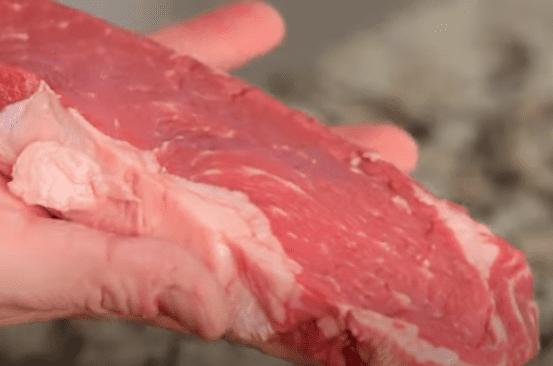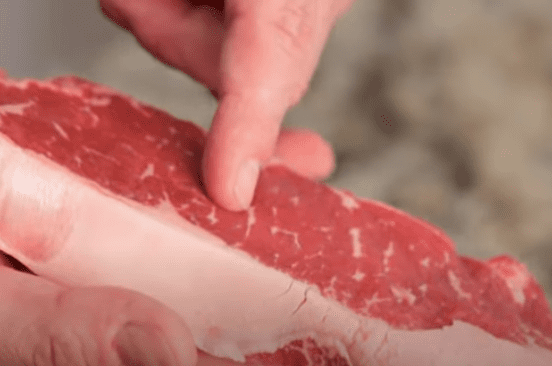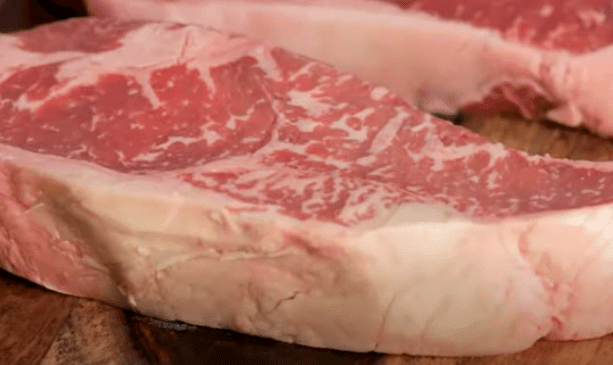When it comes to buying steaks at the market or at a restaurant, it is important to know what you are spending your money on. Being educated on the different USDA beef grades will save you time and money in the long run. Not to mention, you’ll know how to find the tastiest steaks around.
USDA Beef Grades
There are eight different USDA beef grades: prime, choice, select, standard, commercial, utility, cutter and canner. Prime being the highest beef quality and canner being the lowest. When talking steaks the focus is on prime, choice and select. The main criteria that the USDA used when grading beef are intramuscular fat and the maturity of the beef. Color and texture of the beef are also taken into consideration when grading beef.
What is intramuscular fat and why is it important? Intramuscular fat, also known as marbling, is the dispersion of fat within the beef. The grade is judged by the amount and dispersion of fat in the ribeye, which is cut between the 12th and 13th rib. It is important because the marbeleization is responsible for giving the beef its tenderness and boost of flavor. Simply put, the fat is where it’s at! If you want to put this theory to the test, check out our steak taste test experiment, where we taste test the different beef grades.
Beef Quality
When talking steaks the focus beef grades are select, choice and prime.

Select steaks typically lack intramuscular fat. As you can see, they have a lot of just really dense meat. Compared to choice and prime, steak graded select are tough, less juicy and less flavorful because of the lack of marbeleization.

Choice steaks typically have more intramuscular fat than select grade steaks. But have less marbling than prime steaks. USDA choice grades represent the majority of meat that you’re going to find in your market. Filets or rib steaks are some of the best cuts for a choice graded steak.

Last but certainly not least, is the prime steak. Prime is the highest USDA beef grade and is the best quality beef you can find. Prime has the most intramuscular fat which makes it tender and juicy, and gives it a rich, beefy flavor. This represents about 5% of all beef that’s sold in the United States. You’ll find a lot of this at your high end restaurants and steak houses.
Simply put, make it either choice or prime or don’t waste your time. The reality is that you are going to pay more money for higher quality steaks. The next time you go to the butcher shop, focus on the cuts of beef that have the most marbling and the best color. If you found the brief explanation of the different USDA beef grades, let us know if the comments! And don’t forget to subscribe to our Youtube channel, where we make cooking meat made easy.




21 Comments on “Beef Grades Explained”
Great info. But you need to learn that your tight shots are coming from the camera on your right. Holding up the steaks to explain the differences does no good unless you point them at the proper camera. In this video we gat an angled shot of the steaks which didn’t do the job. Shoot it again with the correct placement. I look forward to seeing it. Thanks
Hey man I just came through the drive-thru about 30 minutes ago and you guys put tomatoes on my quarter pounder. I specifically asked for no tomatoes.
I need to speak to your manager.
I am glad to understand the different grades of beef. I buy beef in Nigeria every week without adequate knowledge of the grades. The video is highly inspirational. Thanks for updating my knowledge.
So I guess fat is good now? How many Americans will die because of elevated cholesterol eating this fat? How much fat is in the hamburger meat? In USA people buy leaner cuts and hamburger 80% lean. This Wagyu meat probably would grade 60% for hamburger? If you don’t care about your health or wallet, this stuff is great!
Larry, I thought the same thing. Select sounds like more meat….bang for your buck……and less fat….best for your health.
I get the fat = flavor and texture and cooking ease comment, but….isn’t the more meat and less fat the goal in spending precious budget monies? What am I missing here?
Larry;
I believe you are missing the point here. No one would suggest that a steady diet of the high end, higher fat, high price steaks is either healthy or reasonable. But just like buying premium ice cream once in a while or a gooey, rich, decadent dessert on a special occasion, a great flavorful cut of beef is not to kill you if you don’t eat it on a regular basis. Like anything else, moderation is a good thing, and that very moderation is what allows you to splurge and adapt your diet (and wallet ) to compensate.
Merry Christmas (& enjoy those high fat/sugar/calorie Xmas Cookies… LOL)
I have been to several steakhouses where “prime” rib was choice I feel that is false ad so ASK ahead of time
“marbeleization” s/b marbleization
If I can write like you, then I would be very happy, but where is my luck like this, really people like you are an example for the world. You have written this comment with great beauty, I am really glad I thank you from my heart.
Y’all, don’t shoot the messenger! Of course it’s all about the fat! Fat makes all food taste better. Mashed potatoes without butter? Boring. If you’re worried about fat in your diet, eat a smaller portion of beef, or have it less often. If cholesterol is a problem, don’t eat red meat. Just the way it is The bottom line is knowing the difference, so you can be an informed consumer. If you can see what you’re buying has less marbling, you know it may need to be cooked low and slow, or by a method that involves some liquid. Or cut up for stew meat even.
Sometimes we buy the best of what’s available at the store, only to be disappointed at the first bite. It’s no bang for the buck if you throw half away because it’s tough. I’d rather have an 8 ounce prime fillet than a 16 ounce select fillet!
Perfect answer Linda
Nothing like Prime tender meat. Yes it has and should be fat in meat. When you grill the prime steaks the fat cells bust and usually melt out . What’s left is the most tender beef ever. I raise all my steers on pasture with a feeder if they choose to eat some whole grain and they do. And all the free choice minerals they want. And fresh water. I’m amazed at the beautiful beef when hanging. I think you could cut them with a butter knife. The fat in 100% grass fed beef is hard and sticks greasy feeling in my mouth. I don’t never inject my cattle to worm , vaccinate or ever use antibiotics or hormone implants. And I’m very proud of the beautiful steers I produce. I want sell nothing I wouldn’t feed my family or eat myself. Is exactly why I went to keeping my steer yearlings.
Quack quack quack. Do you need some quarter pounder with that cheeeeeese. XD
Um, taste buds. You’re missing taste buds.
L.A. Mary 3 and 4, this is dispatch. We just received a call from the local Walmart. They’re saying a customer is highly distraught due to the fact that he found a worm in his pork. We will be going phase 5 nuclear on said Walmart. Everyone standfast and await further instructions.
What?
“If you found the brief explanation of the different USDA beef grades, let us know if the comments! “
It was most educational . I have always had a dislike of fat, but now I see it’s role. It’s gone before we eat
good post.
As a retail butcher I can tell you that you get select primals that look like prime all the time. Sometimes you get prime primals that look like wagyu and it isnt surprising when no one buys them unless they are reduced. This is because to the untrained eye select is better. Your average consumer looks for less fatty cuts. We are actually changing a prepack steak from choice to select because the people who aren’t buying prime are buying for the low price. You find primals where you can tell the animal was stressed when it was killed and that changes the meat. Older cows have muscles that already feel tenderized. It’s my honest opinion that you should buy whatever meat is on sale that week. Most times it is the freshest and there are a wider variety to choose from. The prime steak held up on this video is from the end of the primal and is actually a poor example. It actually won’t be very tender because some of what looks like fat there isn’t. The other two examples are from the middle or complete opposite side of the loin. You’d see a greater variance in grades of other cuts tbh. Find a decent butcher who will cut you Chuck eye steaks and you won’t care about grades anymore
I found the post to be good. The shared information are greatly appreciated
Animal fats and cholesterol are not the enemy. You’ve been lied to. Sugar and carbs are the problem.